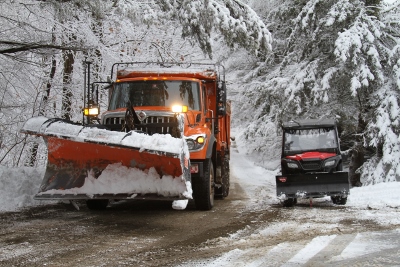So if you’ve been following along, my husband and I have been working to turn two deer hides from deer harvested last fall into buckskin. I’ve detailed the other two steps in the process with photos: Phase 1 and Phase 2.
Now we are onto Phase 3, which is almost the last phase … the final step of the process will be smoking the hide over a smothered fire for two days so that the hides have a nice pale yellow color. (You use a smothered fire to smoke the hides at this stage because a hot fire could actually cook them.) We plan to do this final phase after the five feet of snow melts.

We completed Phase 3 after one of the minor snowstorms that blew into town — not to confuse the negative temperatures with the other snowstorms that followed, leaving us with only a distant memory of this dock surrounded by water instead of being completely submerged by snow:

If you recall, the last step of Phase 2 was to leave the hides submerged in a stream for a week so the running water would soften them. Obviously, once you get them out of the stream, it’s necessary to wring out the excess water, which is a really cold job to do when it’s the middle of winter.
Drape the hide on a branch that has plenty of room around it and beneath it as you will be usng a wooden stake to twist the water out of the hide. Twist eight times clockwise. Unwind the hide. Twist eight times counter-clockwise. This will wring out the excess water.
Twist eight times clockwise. Unwind the hide. Twist eight times counter-clockwise. This will wring out the excess water.

 Bring the hide back inside and fill a bucket with a solution of a gallon hot water, half a cup of grated bar soap and a quarter cup of Neatsfoot Oil.
Bring the hide back inside and fill a bucket with a solution of a gallon hot water, half a cup of grated bar soap and a quarter cup of Neatsfoot Oil.


 Place the hide in the bucket with the solution and pull it and stretch it to really get the hide pliable. Repeat the wringing process like above again before bringing the hide back inside and sit in front of the woodstove. Apply more Neatsfoot oil to the hide and start to work the hide so it will become soft while sitting near the fire. The heat allows the hide to soften. It takes several hours, but the results are worth it.
Place the hide in the bucket with the solution and pull it and stretch it to really get the hide pliable. Repeat the wringing process like above again before bringing the hide back inside and sit in front of the woodstove. Apply more Neatsfoot oil to the hide and start to work the hide so it will become soft while sitting near the fire. The heat allows the hide to soften. It takes several hours, but the results are worth it.
 With ours nearly complete (minus the smoking stage that will occur this spring), we’re brainstorming what we plan to do with the hides. What would you do?
With ours nearly complete (minus the smoking stage that will occur this spring), we’re brainstorming what we plan to do with the hides. What would you do?
 Interested in Archery? Check out Kristen Schmitt’s Video and Join the Fun!
Interested in Archery? Check out Kristen Schmitt’s Video and Join the Fun!
Born and raised in metropolitan Detroit, Kristen Schmitt never thought she’d move away from everything she knew. But a conscious decision to re-evaluate priorities led her and her family to leave the city and move to the country where they could spend more time together, away from the hectic nature of city life. Her decision to pursue archery and bowhunting came after the move – and after talking with numerous women already involved with the sport. Inspired by their drive and confidence, Kristen picked up a bow for the first time a year ago and hasn’t looked back.
In Beginner’s Guide to Archery: For Women you’ll find:
- An overview of the essential archery equipment and gear you’ll need to get started
- Instruction on archery fundamentals
- Coverage of essential hunting topics like scent control, safety, wild food vs. local food, and more


That’s pretty cool. I’m not to sure how my neighbors would take me running the water for a week though.
Out west, a lot of the buckaroos and cowboys (same thing, just depends which state your in) use buckskin for small saddle repairs or wrapping the saddle horn. My Auntie made moccasins from the hides I gave her.